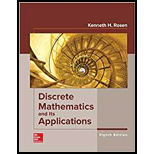
Find the solution of the recurrence relation
Want to see the full answer?
Check out a sample textbook solution
Chapter 8 Solutions
DISCRETE MATHEMATICS+ITS APPL. (LL)-W/A
- Test the claim about the population mean μ at the level of significance α. Assume the population is normally distributed. μ Claim: <4715; α = 0.05 Sample statistics: x = 4917, s = 5501, n = 54 What are the null and alternative hypotheses? Ho: Ha (Type integers or decimals. Do not round.) Find the standardized test statistic t. t = ☐ (Round to two decimal places as needed.) Find the P-value. P = (Round to three decimal places as needed.) Decide whether to reject or fail to reject the null hypothesis. Choose the correct answer below. Ho. There enough evidence at the ☐ % level of significance to Fail to reject Reject .... the claim.arrow_forwardNot use ai pleasearrow_forwardA politician claims that the mean salary for managers in his state is more than the national mean, $85,000. Assume the the population is normally distributed and the population standard deviation is $8700. The salaries (in dollars) for a random sample of 30 managers in the state are listed. At α = 0.01, is there enough evidence to support the claim? Use technology. 92,421 81,412 85,143 97,220 99,317 71,884 97,762 86,108 98,385 73,869 81,391 95,997 98,828 86,476 77,893 74,995 90,472 81,330 92,183 94,649 77,880 91,821 90,907 84,640 78,479 81,703 89,573 89,948 70,938 81,300 (a) Identify the null hypothesis and alternative hypothesis. O A. Ho: " =85,000 Нa: μ85,000 D. Hoi u >85,000 Нa: μ≤85,000 (b) Identify the standardized test statistic. Z= B. Hoμ≥85,000 Haμ85,000 Haμ≤85,000 (Round the final answer to two places as needed. Round all intermediate values to three places as needed.) (c) Find the P-value. Use technology. (Round to three decimal places as needed.) (d) Decide whether to reject…arrow_forward
- i need help please and thank youarrow_forwardi need help please and thank youarrow_forwardThe parameters of an RLC circuit with an input voltage of E(t) are given. R=202, L=10 H, C = 0.01 F, E(t) = 200 cos 4t V Using the initial conditions I(0) = 0 and Q(0) = 4, plot both the steady periodic current I sp(t) and the total current I(t) = Isp (t) + Itr(t).arrow_forward
- Find the steady periodic solution Xsp (t) = C cos (@t - α) of the given equation mx" + cx' + kx = F(t) with periodic forcing function F(t) of frequency w. Then graph xsp (t) together with (for comparison) the adjusted function F₁ (t) : F(t) mo x'' + 4x' + 43x = 9 cos 6tarrow_forwardCan you please solve this and show steps of dimensional analysis. Thank you. The values for A-E are written above. Refer to top paragraph for contentarrow_forward2. (15 pts) Write the Maclaurin series for the function f(x) = sinx. Use it to write the Maclaurin series for g(x) = sin. Express find as a series. Write it in sigma notation as well.arrow_forward
- - Let f (x) = √x sin( X/12), × 0. D x = ○ Show that f is continuous at x=0. 3 Let f(x) = ( + sin(x2) x +0 ' Lo. X = 6 Show that f is discontinuous at x=0. 9 Let a, b & R, acb. Let f be a real-valued function on [a,b]. 10 (a) Define what we mean by "f is bounded." (b) Assume is bounded and let m = M = inf {f(x): xe [a,b]} sup {f(x): x = [a,b]}. Prove that there exist Xo, & [a,b] such that Хо f(xo) Im and f(x) = M. = น Prove the Intermediate Value theorem for f as in ⑦ that for each yε [m,M] there exists. xe [a, b] such that f(x) = y. Conclude that f([a,b]) = [m, M].arrow_forwardA mass weighing 80 lbs (mass m = 2.5 in fps) is attached to the end of a spring that is stretched 8 in. by a force of 80 lbs. A force Fo cos wt acts on the mass. At what frequency (in hertz) will resonance oscillations occur? Neglect damping.arrow_forward①(a) Let rεR, o≤r<1. Prove directly from defintions. 2 = r ++²+3+... that the series r = 1 is convergent with sum 1-2 +p+.... (b) Prove that the harmonic series 2 ½ is divergent. นะเ n ② (a) Define what is meant by the following: (1) the sequence (an) is convergent. (ii) the sequence (an) is Cauchy. (ii) the sequence (an) is bounded. (b) Prove directly from definitions that a Cauchy Sequence is bounded. ③ (a) Prove diredly from definitions that if a Cauchy Sequence (an) has a convergent subsequence then (an) is convergent. (6) Use the results of 2(b) and 3(a) to deduce that a Counchy sequence is convergent. You may assume the Bolzano- Weierstrass Theorem.arrow_forward
- Algebra & Trigonometry with Analytic GeometryAlgebraISBN:9781133382119Author:SwokowskiPublisher:Cengage
 Algebra: Structure And Method, Book 1AlgebraISBN:9780395977224Author:Richard G. Brown, Mary P. Dolciani, Robert H. Sorgenfrey, William L. ColePublisher:McDougal Littell
Algebra: Structure And Method, Book 1AlgebraISBN:9780395977224Author:Richard G. Brown, Mary P. Dolciani, Robert H. Sorgenfrey, William L. ColePublisher:McDougal Littell
 Linear Algebra: A Modern IntroductionAlgebraISBN:9781285463247Author:David PoolePublisher:Cengage Learning
Linear Algebra: A Modern IntroductionAlgebraISBN:9781285463247Author:David PoolePublisher:Cengage Learning
 College Algebra (MindTap Course List)AlgebraISBN:9781305652231Author:R. David Gustafson, Jeff HughesPublisher:Cengage Learning
College Algebra (MindTap Course List)AlgebraISBN:9781305652231Author:R. David Gustafson, Jeff HughesPublisher:Cengage Learning





